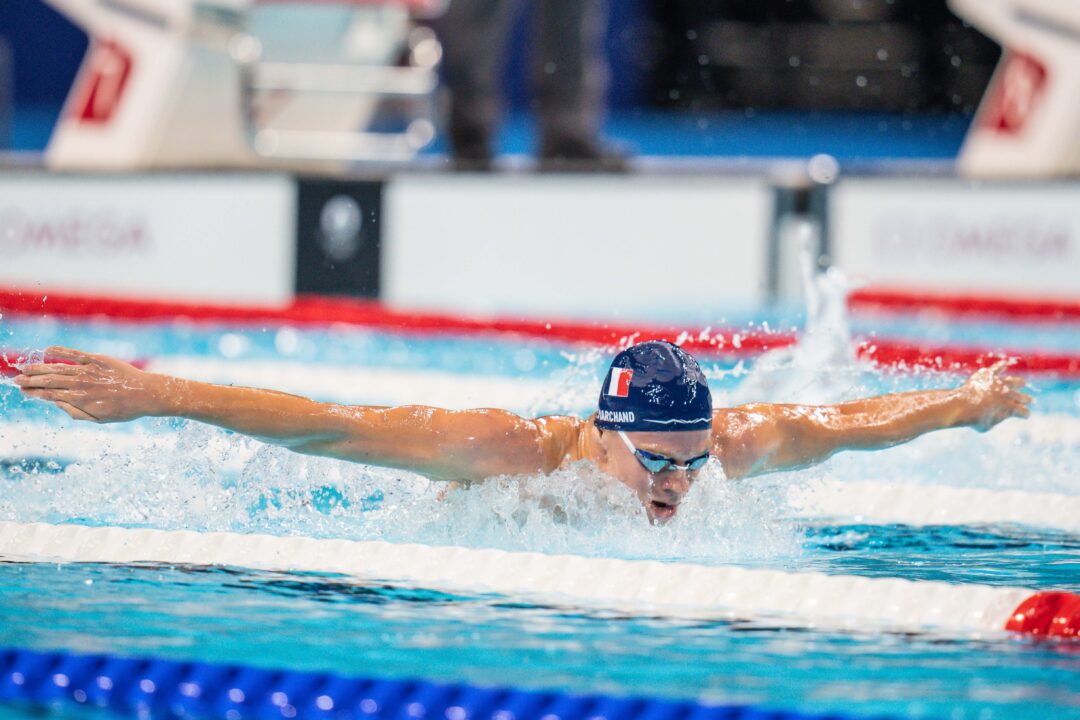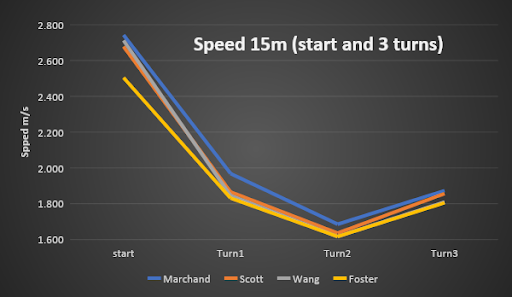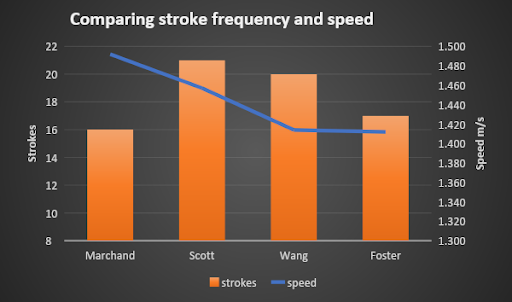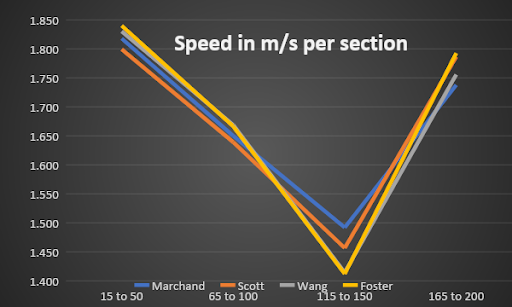Courtesy: Dominique Hérailh
The French Swimming Federation has released detailed statistics on all the swimming finals at the Paris Olympics and in this article, unlike the previous versions where we’ve only looked at the podium, we’ll also be looking at the data on Carson Foster. Why? Because without his poor start, he would have had the bronze medal.
If the 12 labors of Hercule are only a myth, the four gold medals won by Leon Marchand during these Olympics are indeed a reality.
The 200 IM was his last individual race and he was only six one-hundredths shy of matching Ryan Lochte‘s longstanding world record that has been on the books since 2011.
Let’s start with a general overview of the 200 IM in Paris before getting into the full breakdown.
This first table gives the decomposition of the full 200 meters broken down by the underwater portion and the ‘over the water’ segments.
| Marchand | Scott | Wang | Foster | |
| Underwater Distance (m) | 55.0 | 43.9 | 43.4 | 43.5 |
| Time Underwater (s) | 25.81 | 20.51 | 20.36 | 21.17 |
| Value in m/sec | 2.131 | 2.140 | 2.132 | 2.055 |
| Swimming distance (m) | 145.0 | 156.1 | 156.6 | 156.5 |
| Time Over The Water (s) | 88.25 | 94.8 | 95.64 | 94.93 |
| Value in m/s | 1.643 | 1.647 | 1.637 | 1.649 |
| Average speed of 200m | 1.753 | 1.734 | 1.724 | 1.723 |
Leon Marchand’s distance traveled underwater is even more impressive than we might have expected. Duncan Scott, Wang Shun and Foster only went roughly 80% of the distance Marchand traveled underwater, which was a startling 55 meters.
Let’s calculate the advantage Marchand gained by going 55 meters underwater.
1) The Data
- Marchand swam 55 meters underwater in a time of 25.81
- Scott went 43.9 meters in 20.51
- Wang went 43.4 meters in 20.36
- Foster went 43.5 meters in 21.17
- With an extra 11+ meters underwater, where you’re traveling faster than over the water, Marchand picked up significant ground in that small portion alone
2) Calculating The Advantgae Marchand Gained With More Yime Underwater
- Of his deviation from Marchand’s UW at the start and each of the three turns,
- The percentage of each deviation from the total deviation
- Of his average speed over each of the four strokes calculated on the basis of the results of the 35m.
3) Results
- Marchand: 25.81
- Scott: 20.51 + 6.42 = 26.93 (or +1.12)
- Wang: 20.36 + 6.79 = 27.15 (or +1.34)
- Foster: 21.17 +6.49 = 27.66 (or +1.85)
Let’s not jump to conclusions about what the results would have been for the others had they traveled the same distance underwater. If Scott, Wang or Foster pushed to go 55 meters underwater, they may well have swam significantly slower during the race.
What you gain on one side can be lost on the other.
The following graph shows the consequences of UW at 15m: an advantage for Leon Marchand, and a distinct disadvantage for Carson Foster, especially at the start.
Let’s break down the race.
Marchand’s reaction time at the start was the slowest of the four (0.67). The best was Scott (0.62) followed by Wang and Foster (0.64).
Start to 15 meters
| Marchand | Scott | Wang | Foster | |
| Time (s) | 5.47 | 5.60 | 5.53 | 5.99 |
| Value in m/sec | 3.30 | 3.26 | 3.27 | 3.04 |
Carson Foster seems to have lost the bronze medal at the start. Without the 46 one-hundredths he lost to Wang, he could theoretically have broken 1:56.
Leon Marchand had a great start, much faster than he was opening up the 200 fly (5.47 vs 5.66).
15 Meters to 50 Meters
| Marchand | Scott | Wang | Foster | |
| Time (s) | 19.25 | 19.45 | 19.12 | 19.02 |
| Value in m/sec | 1.818 | 1.799 | 1.831 | 1.840 |
In this sector, Carson Foster was the fastest. He had to make an effort to erase his deficit from his bad start. Wang Shun was also quick on fly.
50-Meter Standings
- Wang 24.65
- Marchand +0.07
- Knox + 0.09
- Seto +0.20
- Dean +0.31
- Razzetti +0.35
- Foster + 0.36
- Scott +0.40
First Turn
| Marchand | Scott | Wang | Foster | |
| Time 15 Meters | 7.62 | 8.04 | 8.13 | 8.19 |
| Value in m/s | 1.97 | 1.87 | 1.85 | 1.83 |
It was at the first turn that Leon Marchand had his best underwater. His three main competitors were more than 40 or 50 one-hundredths of a second slower. Only Daiya Seto and Finlay Knox were within three-tenths.
65 Meters to 100 Meters
| Marchand | Scott | Wang | Foster | |
| Time | 21.21 | 21.35 | 20.97 | 21.00 |
| Value in m/s | 1.650 | 1.639 | 1.669 | 1.667 |
Wang and Foster logged the same time through this sector. Marchand took over the lead at the 65-meter mark and never relinquished it.
100-Meter Standings
- Marchand 53.55
- Wang +0.20
- Foster +0.65
- Scott +0.89
Second Turn
| Marchand | Scott | Wang | Foster | |
| Time 15 Meters | 8.90 | 9.17 | 9.28 | 9.28 |
| Value in m/s | 1.685 | 1.636 | 1.616 | 1.616 |
Marchand’s excellent gliding qualities are again demonstrated in this second turn. By comparison, at equal length, the underwater of Knox was 82 one-hundredths of a second slower.
115 Meters to 150 Meters
| Marchand | Scott | Wang | Foster | |
| Time | 23.46 | 24.03 | 24.75 | 24.79 |
| Value in m/s | 1.685 | 1.636 | 1.616 | 1.616 |
At 150 meters, the race was over. The only uncertainty was about whether or not Marchand would break the world record. Note that his time of 23.46 is nearly identical to what he did on the third 50 of the 200 breast (23.43).
The following graph compares stroke frequency and speed.
We can see the effectiveness of Marchand’s breaststroke, which is the fastest in the field with the fewest strokes.
150-Meter Standings
- Marchand: 1:25.91
- Scott: +1.73
- Wang: +1.87
- Foster: +2.36
Third Turn
| Marchand | Scott | Wang | Foster | |
| Time 15 Meters | 8.01 | 8.08 | 8.29 | 8.31 |
| Value in m/s | 1,873 | 1,856 | 1,809 | 1,805 |
Although he had the fastest time over these 15 meters, Marchand’s final underwater was slower than his last turn in the 400 IM, though it’s important to note that this turn was from the feet while in the 200 IM was from his hands coming off breaststroke.
- 400 IM turn 7: UW = 14.13m Time=7.05 speed = 2.01m/s
- 200 IM turn 3: UW = 13.78m Time= 7.33 speed = 1.88m/s
165 to 200 Meters
| Marchand | Scott | Wang | Foster | |
| Time | 20.14 | 19.59 | 19.93 | 19.52 |
| Value in m/s | 1.738 | 1.787 | 1.756 | 1.793 |
Foster was the fastest coming home on freestyle, just like he was the fastest on fly excluding the underwaters.
The chart below shows that Foster was fastest (or tied with Wang) on three of four sectors. In addition to the underwaters, breaststroke proved to be the key difference maker between Marchand and Foster.
At the finish, Marchand touched in 1:54.06, followed by Scott at 1:55.31, Wang in 1:56.00 and Foster in 1:56.10
Conclusions
- Marchand’s underwaters contributed greatly to his victory. Paradoxically, it was his last underwater that may have prevented him from breaking the world record.
- Scott earned his silver medal by being consistent across the board. He was the second-fastest swimmer overall on the 15-meter/underwater sectors, and third on the 35-meter/’over the water’ sectors.
- Wang was blazing-fast on the front half, leading at the 50 and sitting second at the 100. He was third-fastest over the 15-meter sectors and fourth in the 35-meter sectors.
- Foster’s relatively slow start saw him trailing early, and he was the slowest of the four on the underwaters. However, he was second to Marchand on the 35-meter sectors. The breaststroke is undoubtedly the stroke he lost the most ground.




So foster would have won if they took away all the turns… bob bowman should help fix that
200 IM was quite a race!! Margins were pretty small time-wise. Great races from everyone in that final! Anyone who can make an Olympic final is very talented!
Marchand first to sub 1:54 next year? Which split would he save time on?
Probably micro improvements on a couple of legs. Im not sure theres one section that he could lob off a chunk of time
i mean like Ryan Lochte’s over 13 year WR has stood so long for a reason…
i think Leon’s free needed a bit more energy, but then again breaststroke may have tired him out so he couldn’t; go any harder on free?
Does anyone know exactly what Marchand does to make his underwaters, including the pullout with only one dolphin kick, so fast? From the underwater video that I’ve seen, he doesn’t look particularly special, but it seems he must be doing something different.
I’ve had a similar question about Pan, what makes his freestyle so fast? I don’t believe that he’s doping, but he’s doing something unique to smoke the field like that in the Olympics.
Pan has a unique stroke that seems to be largely driven by his kick and not his arms, unlike the dominant 1 freestylers we’ve seen. His stroke is also exceptionally low to the water. He swims it a lot more like a 200 freestyler than it seems he should be able to for his speed.
I agree, his stroke is very unique. It would be interesting to see someone who specializes in hydrodynamics breakdown his technique.
While I agree that body position is very important, I think that there’s more to it when you’re talking about underwater kicking,
It all comes down to body position. Both of these swimmers have achieved the optimal body position for aerodynamics in their respective events
You mean hydro
The last turn analysis is not quite apples-to-apples, as the 400IM is from the feet, while the 200Im is from the hands.
Either way, a really interesting analysis, and wow, what a race!
You’re right, I made a mistake. Sorry!